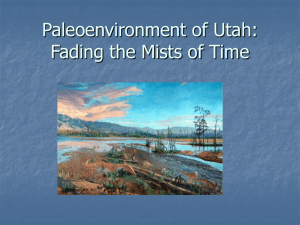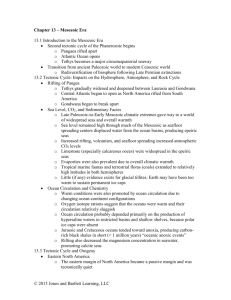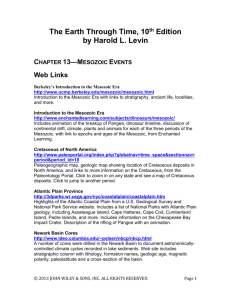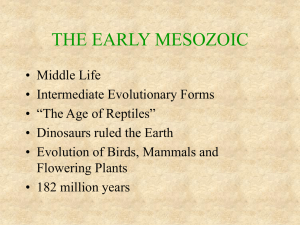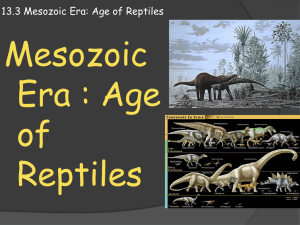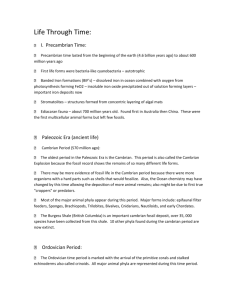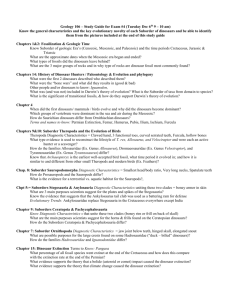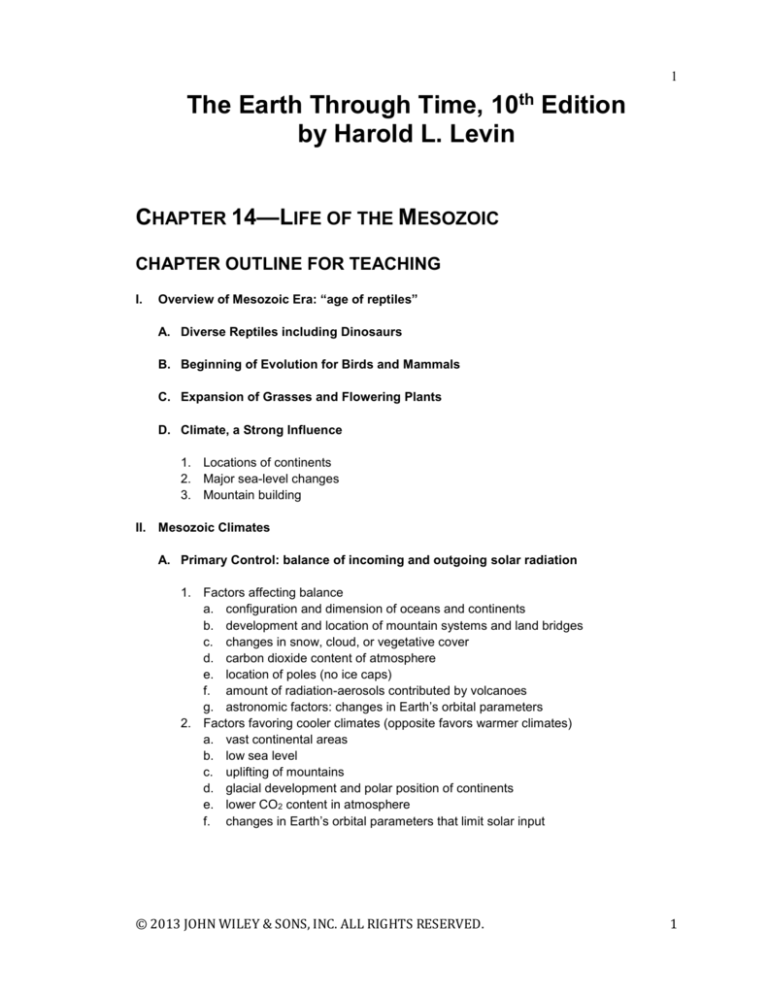
1
The Earth Through Time, 10th Edition
by Harold L. Levin
CHAPTER 14—LIFE OF THE MESOZOIC
CHAPTER OUTLINE FOR TEACHING
I.
Overview of Mesozoic Era: “age of reptiles”
A. Diverse Reptiles including Dinosaurs
B. Beginning of Evolution for Birds and Mammals
C. Expansion of Grasses and Flowering Plants
D. Climate, a Strong Influence
1. Locations of continents
2. Major sea-level changes
3. Mountain building
II. Mesozoic Climates
A. Primary Control: balance of incoming and outgoing solar radiation
1. Factors affecting balance
a. configuration and dimension of oceans and continents
b. development and location of mountain systems and land bridges
c. changes in snow, cloud, or vegetative cover
d. carbon dioxide content of atmosphere
e. location of poles (no ice caps)
f. amount of radiation-aerosols contributed by volcanoes
g. astronomic factors: changes in Earth’s orbital parameters
2. Factors favoring cooler climates (opposite favors warmer climates)
a. vast continental areas
b. low sea level
c. uplifting of mountains
d. glacial development and polar position of continents
e. lower CO2 content in atmosphere
f. changes in Earth’s orbital parameters that limit solar input
© 2013 JOHN WILEY & SONS, INC. ALL RIGHTS RESERVED.
1
2
B. Triassic
1. Relatively cool
a. Pangaea continents still clustered
b. sea level was lower
c. mountain building, many highlands
2. Paleo-equator: central Mexico to northern Africa
3. Wind shadow deserts (aridity) in continental interiors
a. red beds
b. evaporites
C. Jurassic
1. Relatively mild
a. no glacial deposits
b. evidence of monsoons and aridity
c. coals in many spots including Antarctica
d. tropical conditions in wide belts
2. Continents at latitudes of today
a. Atlantic opening
b. Tethys was an arm of proto-Pacific: warm ocean currents flowed through Tethys
D. Cretaceous
1. Relatively warm
a. subtropical flora at ± 70o of equator
b. high and low latitude coals
c. high sea-level stand: maximum inundation of Phanerozoic
2. Continents near today’s position
a. Arctic Canada near the North Pole
b. Antarctica at South Pole
3. End-Cretaceous change
a. rapid cooling and temporary vast chilling
b. vast regression
c. major mountain building
d. plankton-produced CO2 shortage
e. volcanic activity
4. Terminal Cretaceous climatic event
a. tropical cycads sharply reduced
b. hardy conifers and angiosperms expanded
c. oxygen isotope studies of shells show ocean temperature decline began 80
million years ago
d. strong connection to global extensions at 65.5 million years ago
© 2013 JOHN WILEY & SONS, INC. ALL RIGHTS RESERVED.
2
3
III. Mesozoic Invertebrates
A. Marine Invertebrates: Middle Triassic resurgence
1. Pelecypod bivalves (mainly oysters)
a. Gryphaea: a small oyster
b. Exogyra: a large oyster
c. Rudistids (horn-like valve, left valve as “lid”): reef former of Jurassic-Cretaceous
2. Scleractinian corals (proliferated in equatorial Tethys)
a. hermatypic (reef builders): normal salinity, less than 50 m water, 20o C, algal
symbionts
b. ahermatypic (non-reef corals): not so restrictive
3. Echinoderms
a. starfish, sea urchins, crinoids, ophiuroids
b. regular echinoids: 5-fold symmetry, spherical shell (test), numerous in European
chalks (Early Cretaceous)
c. irregular echinoids: displaced regular echinoids during Cretaceous, flattened
forms, bilateral symmetry
d. crinoids: including stemmed types (e.g., Pentacrinus) and stemless forms (e.g.,
Uintacrinus)
4. Ammonoid cephalopods (Mesozoic also “age of ammonoids” —widespread,
abundant index and guide fossils)
a. three groups
(i) goniatites
(ii) ceratites
(iii) ammonites
b. suture pattern (septal fluting where septum joins inner wall): key to taxonomy
c. septal fluting: related to function as pressure-resisting support and/or function as
attachment for fleshy parts
d. variety due to environmental adaptation: expansion follows sea level rise and
epicontinental sea flooding
e. diversity of forms: planispiral (Early Cretaceous) to open spirals, straight conchs,
helicoids (Late Cretaceous)
f. assemblage decline and extinction at End-Cretaceous
g. nautiloids: sole survivor of extinction
5. Belemnite cephalopods
a. highly successful: Jurassic-Cretaceous
b. straight, pointed conch shell
c. moved through water by jetting propulsion
d. related to squid and octopus
6. Gastropods
a. helicoids conchs with cap shells
b. reef, beach dwellers
7. Crustaceans: barnacles, crayfish, lobsters, crabs, shrimp, ostracodes (abundant
during Jurassic-Cretaceous)
© 2013 JOHN WILEY & SONS, INC. ALL RIGHTS RESERVED.
3
4
8. Protozoans: radiolarians and foraminifers
a. prolific in Jurassic-Cretaceous
b. radiolarians: siliceous tests and oozes (chert)
c. foraminifers: calcium carbonate tests (forams); widespread index fossils that are
important for correlation; benthic (Jurassic) and planktonic (Cretaceous);
contributor to chalk deposition
B. Terrestrial Invertebrates: limited preservation record
1.
2.
3.
4.
5.
Air-breathing snails
Freshwater clams
Freshwater ostracodes
Centipedes, spiders, millipedes, scorpions
Insects: several groups appeared before end of Jurassic (preserved best in amber)
IV. Mesozoic Vertebrates
A. Amphibians: rise of modern forms
1. Temnospondyls: surviving group of tetrapods from end-Permian extinction
a. Triassic - 17 families survived
b. Jurassic - 2 lineages survived
c. Cretaceous - 1 lineage survived
2. Oldest forms known
a. oldest frog: Triadobatrachus (in Lower Triassic, Madagascar)
b. oldest salamander: Karaurus (in Upper Jurassic, Kazakstan)
c. oldest caecilian: Eocaecilia (in Lower Jurassic, Arizona)
3. Modern forms that survive today
a. frogs and toads (anurians)
b. salamanders and newts (urodelans)
c. limbless amphibians (caecilians)
B. Triassic Transition: continuity among land animals
1. Survivors of Permian extinction
a. amphibians
b. mammal-like reptiles
2. New reptile groups
a. first turtles (toothed turtles)
b. rhynchocephalians (tuataran lizards)
c. archosaurs: crocodiles, flying reptiles, thecodonts, dinosaurs
3. Example “basal archosaur”: Hesperosuchus
a. small, agile, light, long tails, short forelimbs
b. walked erect, bipedal
c. caught prey with forelimbs
d. forelimbs evolved to wings
e. ancestors of dinosaurs and flying reptiles
4. Phytosaurs: reverted to 4-legged stance; some armored (crocodile-like forms); an
example of convergence in evolution; phytosaur nostrils just ahead of eyes on snout
© 2013 JOHN WILEY & SONS, INC. ALL RIGHTS RESERVED.
4
5
5. Diapsid groups
a. lepidosaurs: snakes, lizards, and their ancestors
b. archosaurs: ornithischian and saurischian dinosaurs, flying reptiles (pterosaurs),
and archosaurs
C. Triassic-Jurassic Extinction Event
1. 199.6 million years ago
2. 20% of marine families and many large land animals lost
3. Probable causes: sea-level change and ocean anoxia
D. Dinosaurs
1. Composed of two orders: saurischia (lizard-hipped) and ornithischia (bird-hipped)
a. Saurischia: triradiate pelvic bones like thecodonts
b. Ornithischia: pubis parallel to ischium-like birds
c. earliest dinosaurs: saurischia (Triassic, 225 million years old, Argentina)
2. Saurischians: “first dinosaurs” and small forms
a. Eoraptor and Herrerasaurus: Late Triassic forms called “first dinosaurs”
(Argentina)
b. Coelophysis: a younger Late Triassic dinosaur (New Mexico)
c. Ceratosaurus: the saurischian with a nasal horn
3. Carnivorous saurishians or theropods (larger carnivores; hind limbs robust; claws on
toes; small forelimbs; serrated teeth)
a. Deinonychus and Velociraptor: Cretaceous predators
b. Family Allosauridae: Allosaurus (U.S.)
c. giant theropods: Tyrannosaurus (13 m, 4 tons, North America); Gigantosaurus
(Argentina); Carcharodontosaurus (Africa)
4. Herbivorous saurischians or sauropodomorphs (Jurassic-Cretaceous)
a. subdivided into prosauropods and sauropods
b. long necks, long tails, 4-limbs stance
c. Apatosaurus (formerly ‘Brontosaurus;’ Jurassic, Colorado): 30 tons
d. Brachiosaurus: longer forelimbs to reach higher vegetation
e. Supersaurus: 80 to 100 tons
f. sauropodomorphs left extensive foot-print record (“track ways” of Colorado, for
example)
g. advantages of size: avoid predators, slow temperature changes due to surfaceto-mass ratio (gigantothermism)
© 2013 JOHN WILEY & SONS, INC. ALL RIGHTS RESERVED.
5
6
5. Ornithischians (Late Triassic-Cretaceous)
a. characteristics: beak for cropping plants, quadrupeds and bipeds (primitive), jaw
allows teeth closure at one time
b. Ornithopods: bipedal forms
(i) heterodontosaurs
(ii) hypsilodonts
(iii) iguanodonts
(iv) hadrosaurs
c. Hadrosaurs (trachodonts): web-footed aquatic adaptation; vertically flattened tail
for swimming; nesting behavior; broad flat toothless face (“duck bill” dinosaur);
abundant chewing teeth
(i) hadrosaurines
(ii) lambeosaurines
6. Thyreophorans
a. Stegosaurs: two-paired, spiked tail; heavy plates protruding from spine along
back and tail (defense or temperature regulation)
b. ankylosaurs: bony plates over sides and back; squat format; small head; weak
teeth
(i) with bony tail club: ankylosaurs
(ii) without bony tail club: nodosaurs
7. Marginocephalia
a. pachycephalosauria
b. ceratopsia
(i) psittacosauridae (Psittacosaurus)
(ii) neoceratopsia (Protoceratops; Triceratops; Kosmoceratops)
8. Dinosaurs: warm-blooded?
a. ectothermic: rely on outside temperature
b. endothermic: generate body heat (e.g., mammals and birds)
c. Ostrom’s proposal: include dinosaurs and birds in a new “Class Dinosauria”
d. Bakker’s evidence for warm bloodedness: stance-like mammals; microscopic
bone structure-like mammals; isotopic variability in bones like warm-blooded
vertebrates; predator/prey ratios; Mesozoic climates
9. Dinosaurs and birds
a. several Chinese dinosaurs with feathers: Caudipteryx and Protoarchaeopteryx
b. other feathered dinosaurs?
10. Dinosaur parenting behavior
a. Horner’s (1984) Maiasaura (“good mother lizard”) hypothesis about nesting sites
in Cretaceous of Montana
b. Horner’s evidence: hadrosaur nests with clutches of 20 eggs, nests 7.5 m apart;
babies stayed in nests during ± 3 years growth; fed in nests; decaying vegetation
placed over eggs by adults
c. Norell’s (1993) work in Gobi Desert, Mongolian: Oviraptor and Protoceratops
nests with eggs and embryos; evidence of incubator behavior
© 2013 JOHN WILEY & SONS, INC. ALL RIGHTS RESERVED.
6
7
D. Aerial Reptiles: adaptive radiation of Permian forms
1. Gliders with skin wings
a. Coelurosauravus (Permian-Triassic)
b. Icarosaurus (Triassic)
2. Gliders with long, modified ribs functioning as wings: Longisquama (Triassic of
Kyrgyzstan)
3. Active flyers: pterosaurs (Late Triassic-Cretaceous)
a. Sharovipteryx (Traissic contemporary of Longisquama: skin membrane between
elbows and knees—rear legs to tail, a “parachute” glider)
b. Sordes pilosus (“hairy devil”): “hair” covered, wing-flapping reptile; hair longer on
under side for egg incubation
c. common characteristics: large heads and eyes; long jaws; thin slanted teeth;
fourth finger bones long to support wing; skin sail as wings
d. two general groups evolved: rhamphorphynchoids (primitive long-tailed) and
pterodactyloids (tail-less)
e. Pteranodon: example of tail-less pterodactyloid; 7 m wingspan
f. Quetzalcoatlus northropi (Late Cretaceous, Texas): pterosaur with wingspan of
12 m
g. Pterodausto (Cretaceous, Argentina): long curved jaws with teeth
E. Marine Reptiles: return to sea
1. Nothosaurs (paddle-shaped limbs)
a. appearance during Triassic
b. ancestors of plesiosaurs
2. Placodonts
a. mollusk-eating reptiles
b. paddle-shaped flippers
c. pavement-type teeth in jaws and palate (shell crushing function)
3. Plesiosaurs
a. first appearance during Jurassic
b. short, broad bodies with flippers, small heads
c. long-neck and short-neck forms
d. slender curved teeth (fish-eater)
e. examples
(i) Elasmosaurus (Cretaceous, 12 m long, long-neck form)
(ii) Kronosaurus (Early Cretaceous, 3 m long, short-neck form)
4. Ichthyosaurs (reptilian counterparts of modern toothed whales)
a. fish-like tail, boneless dorsal fin, paddle limbs
b. large eyes with boney plates to protect them
5. Mosasaurs: giant sea-going lizards; vertically flattened tails; an extra hinged lower
jaw; fish and mollusk-eater; out-competed the crocodiles
6. Sea turtles: example Archelon, a 4 m Cretaceous turtle
© 2013 JOHN WILEY & SONS, INC. ALL RIGHTS RESERVED.
7
8
F. Birds
1. Evidence that ancestors were likely Triassic theropods similar to Velociraptor
a. bipedal stance
b. pelvic structure
c. feathers as modified scales
d. beak as toothless jaw
2. First undisputed bird: Archaeopteryx
a. primitive wings
b. feathers
c. jaws with teeth
d. lizard-like tail
e. claw-bearing free fingers (climbing and grasping)
3. Earliest bird with toothless beak: Confuciusornis
a. long tail and claws on wings
b. several million years older than Archaeopteryx
4. Non-flying (swimming) birds (Cretaceous): Hesperornis
a. feathers, no wings
b. webbed feet
5. New fossil finds documenting dinosaur-bird connections
a. Liaoning Province, northern China
b. key interval in China: 120 to 131 million year ago
c. Sinosauropteryx
G. Mammals: groups recognized on tooth morphology
1. Most primitive (Late Triassic) mammals
a. has vestigial reptilian structures
b. have two new inner ear bones
c. mammalian jaw structure and teeth (incisors, molars, canines, premolars)
d. Morganucodon (Late Triassic, Wales); Megazostrodon; Eozostrodon
2. Docodonts: multicusped teeth
a. monotreme ancestors
b. fed on insects
3. Triconodonts: cheek teeth with 3 cusps in a row
a. size of modern cat
b. fed on smaller vertebrates
4. Symmetrodonts: triangular-plan molars
5. Multituberculates: many-cusped teeth; survived for 100 million years starting during
Late Jurassic
a. herbivores
b. chisel-like incisors
c. rodent-like appearance (ground dwellers)
6. Subdivision of mammalian groups (present by Middle Jurassic)
a. prototherians: triconodonts, multituberculates, monotremes
b. therians: marsupials (euherians) and placentals
c. gave rise to marsupials and placentals during Late Cretaceous
d. long, slender toothy jaws
e. earliest known placental mammal: Eomaia (Early Cretaceous, China)
© 2013 JOHN WILEY & SONS, INC. ALL RIGHTS RESERVED.
8
9
V. Mesozoic Flora: “age of the cycads”
A. Marine Plants (Phylum Chrysophyta)
1. Characteristics
a. suspended in water
b. no vascular or support system
c. typically unicellular or colonial
2. Geologic record of phytoplankton (floating plants)
a. pre-Mesozoic: not mineralized (cyanobacteria, green algae, architarchs)
b. Mesozoic: mineralized coverings (coccolithophorids, dinoflagellates,
silicoflagellates, diatoms)
3. Most important Mesozoic phytoplankton (microfossils-0.1 mm and smaller)
a. dinoflagellates (Jurassic-present): sporopollenin walls; cysts preserved as
microfossils
b. coccolithophorids (Jurassic-Cenozoic): calcium carbonate plates (coccoliths)
cover cell; accumulation of coccoliths called marine calcareous ooze
c. silicoflagellates (Cretaceous-present): diatoms having siliceous cell coverings;
spiney and stellate forms; covering called frustule (epitheca = upper half,
hypotheca = lower half)
B. Terrestrial Plants
1. Cycads (Phylum Cycadophyta): seed plants in which true flowers have not developed
a. cycadeoids (fossil cycads)
b. cycadales (true cycads, e.g., sago palm)
2. Conifers: 6 families in Jurassic-Cretaceous
3. Angiosperms: seed and flower-bearing
a. Middle Cretaceous-present
b. birch, maple, walnut, beech, sassafras, poplar, willow
c. abundance and diversity surpassed non-flowering plants
4. Impact of Mesozoic floral revolution
a. co-evolution of insects, birds, reptiles, and mammals
b. production of seeds, nuts, fruits
c. advent of flora color due to competition for pollination
© 2013 JOHN WILEY & SONS, INC. ALL RIGHTS RESERVED.
9
10
VI. Late Cretaceous Catastrophe: second great biotic crisis of the Earth; 65.5 million years
ago; 25% of all known families lost
A. Oceanic Realm Extinctions
1. Vertebrates
a. ichthyosaurs
b. pleisosaurs
c. mosasaurs
2. Invertebrate groups completely lost
a. ammonoid cephalopods
b. belemnites
c. rudistid pelecypods
3. Invertebrate groups: loss of many families
a. echinoids
b. bryozoans
c. planktonic foraminifers
d. calcareous phytoplankton
B. Terrestrial Extinctions: dinosaurs and pterosaurs
C. Reptile survivors: turtles, snakes, lizards, crocodiles, tuataran lizard
(Sphenodon)
D. Possible Extraterrestrial Causes
1. Asteroid impact
a. Alvarez’ theory: elemental iridium enrichment 30 times normal in terminal
Cretaceous clay indicates vaporization of asteroid on impact with Earth; iridium
enrichment too great for terrestrial-source explanation; bolide (comet, asteroid,
meteorite) impact
b. support more likely for Alvarez’ theory: iridium clay found at same level in
Denmark, Spain, New Zealand, N. America, Austria, Haiti, Russia, and in Atlantic
and Pacific sediment cores
c. other support: shocked quartz, soot component in clay, 180 km diameter crater in
Yucatan, Mexico; Antarctic fish kill; tsunami deposits in the Gulf of Mexico region
2. Massive volcanism Deccan (and other sites) 65.5 million years ago: possible iridium
source; antimony and arsenic enrichment in clay suggest volcanism elemental
distribution in 30-40 cm of clay suggests lengthy event; impact may have occurred
but aided biotic crisis, not caused it
3. Cosmic ray bombardment
a. magnetic reversal-induced event: reversal of field causes lowering of electromagnetic shield against normal cosmic rays; rays cause genetic damage and
lethal mutations; does not explain water-shield effects or some lack of age
correlation of extinction with times of known reversals
b. supernova-induced: cosmic ray bursts may occur with periods of 70 million years
based on astronomical statistics
© 2013 JOHN WILEY & SONS, INC. ALL RIGHTS RESERVED.
10
11
E. Possible Terrestrial Causes
1. Loss of epicontinental seas due to rapid sea-level fall at end Cretaceous
2. Change in water chemistry due to sudden release of Arctic Ocean water which was
fresh not saline-like Cretaceous ocean
3. Widespread volcanism: dust, aerosols, greenhouse gasses, acid rain
4. Mitigation of effects to collapse food chain
Answers to Discussion Questions
1. Chalk is particularly by abundant in Cretaceous strata. Foraminifers (“forams”) are singlecelled protozoans that began to proliferate as plankton during Cretaceous. Their tests make
up much of Cretaceous chalk (along with coccolithophores). Chalks were rare during
Paleozoic (and any pre-Cretaceous rocks) because foraminifera were not nearly as common
in younger and older seas as during Cretaceous.
2. Diatoms are silicoflagellate phytoplankton. They are made of silica, whereas
coccolithophores are made of calcium carbonate. Diatoms are built like a box with a lid and
base; coccolithophores are spherical with tiny armor plates over their surface. Diatoms are
commonly associated with cold sea water whereas coccolithophores are not. Being
composed of silica, diatoms are more chemically stable in slightly acidic water than are
calcium-carbonate plankton like coccolithophores.
3. Jurassic flora was dominated by cycads, ginkgoes, seed ferns, and conifers. After middle
Cretaceous, angiosperms prevailed. The shift to angiosperms coincided with global warming
during Cretaceous (abetted by Pangaean breakup and continental movements).
4. Ammonoid cephalopods are mollusks that were pelagic swimming animals during Mesozoic,
which attained global distribution and are thus exceptionally useful for as guide and index
fossils in correlation. Ammonoid cephalopods are distinguished from nautiloid cephalopods
(an extant group) by their complex suture patterns along joints between chambers.
5. Foraminifers are single-celled protozoans, which build durable tests and have an abundant
Mesozoic and subsequent fossil record. Because of their small size and strong tests, large
numbers of foraminifers can be obtained unbroken from small pieces of rock recovered while
drilling for oil and (or) gas. Because most planktonic species were widely distributed in the
world’s oceans, they are useful for age determination and temporal correlation. As sensitive
indicators of water temperature, salinity, and depth, they are useful for reconstructing ancient
environmental conditions.
6. Mesozoic marine invertebrate faunas are dominated by mollusks, especially pelecypods and
cephalopods. Mesozoic could be called the “era” of the ammonoids and oysters. In the
older, Paleozoic seas such groups as trilobites, brachiopoids, bryozoans, graptolites, and
echinoderms dominated. Reef formers of Mesozoic were scleractinian corals; Paleozoic reefbuilders were stromatolites, stromatoporoids, primitive corals, and echinoderms. Paleozoic
groups not seen at all during Mesozoic are trilobites, graptolites, many brachiopods and
corals, archaeocyathids, and stromatoporoids.
© 2013 JOHN WILEY & SONS, INC. ALL RIGHTS RESERVED.
11
12
7. Endothermy in dinosaurs is suggested by their mammal-like stance, microscopic bone
structure of blood vessels, isotopic variability in bones like that seen in living endotherms,
apparently low predator/prey ratios, and the challenges of Late Mesozoic climates. Large
forms like the giant saurischians would have a smaller surface to volume ratio than small
dinosaurs, thus endothermy would not be so critical for them.
8. Cretaceous mammals had an exceptionally reliable system of body temperature control,
small size, and effective reproductive anatomy which may have allowed them to have an
advantage over many reptiles in surviving the end-Cretaceous catastrophe.
9. World geography at the end of Permian was characterized by a single continent, Pangaea, in
an equatorial position. By the end of Cretaceous, the supercontinent had rifted and split into
all the major continental pieces that we have seen today. The global geography during
Mesozoic and was more like today.
10. The classes Aves and Dinosauria first appear during Mesozoic.
11. Pterosaurs and birds (as well as ichthyosaurs and fish) are two examples of convergent
evolution of large groups.
12. (a) The evolutionary importance of “basal archosaurs” is that they were diapsid ancestors of
both the dinosaurs and the flying reptiles. (b) The evolutionary importance of Archaeopteryx
is that this species is the first undisputed bird fossil and is a close evolutionary link between
small, bipedal theropods and modern birds. (c) The evolutionary importance of angiosperms
lies in the coevolutionary relationship between many angiosperms and many types of insects.
13. Feathers may function as insulation, camouflage, or display.
14. Convergent evolution is the process of producing similar physical forms in unrelated
organisms. Because they are unrelated, the similarity of ornithischian dinosaur hip bones
and bird hip bones seems more coincidental than convergent.
15. Reptile groups surviving the end-Cretaceous extinction are: turtles; snakes; lizards;
crocodiles; and tuataran lizards.
16. Oceans cover 71% of the earth’s surface and the ocean floor, because it is continually
moving and re-melting, is at its oldest Early Mesozoic. This is so because of the rifting
following the breakup of Pangaea. As Early Mesozoic, say 230 million years ago, is relatively
recent in Earth’s long history, the record of craters will be minimal on the seafloor.
17. Evidence for the terminal-Cretaceous bolide impact includes iridium-enriched clay at many
locales, shocked-quartz grains, tektite beds, soot within boundary clay, and 180 km crater in
Yucatan, Mexico. Evidence against the hypothesis is antimony and arsenic concentrations in
boundary clay favoring a volcanic origin for the unusual chemistry. Deccan and same-age
basaltic outpourings of lava data at 65.5 million years suggest a volcanic source. The
thickness of boundary clay and the homogenous elemental distribution suggest deposition
over long time. Further, not all extinctions seem to be truly simultaneous. Some groups were
in decline for several million years.
© 2013 JOHN WILEY & SONS, INC. ALL RIGHTS RESERVED.
12
13
18. The Deccan Traps were extruded 65.5 million years ago at the same time as many other
basaltic outpourings. The aerosol, dust, and greenhouse gas contribution of such eruptions
would have been enormous. The CO2 contribution could have poisoned the upper 45 to 100
m of seawater, thus making it lethal for key plankton. Collapse of the marine food chain
could have resulted.
19. a
20. e
21. b and d
Chapter Activities
Student activities for in-depth learning.
1. Take a look at this web page on ammonites (http://www.fossilmuseum.net/Fossil_Galleries/
Ammonites.htm) and address the following questions. Why are ammonites so aesthetically
pleasing? Of what is an ammonite shell composed? How do ammonites grow and how do they
float and move in the water. How has ammonite morphology (shape) changed over time?
2. Using the resources linked to this page (http://www.enchantedlearning.com/subjects/
dinosaurs/dinoclassification/), find simple sketches of the lizard-hipped and bird-hipped pelvic
bones and re-draw them for yourself. Label the three main bones, the ilium, ischium, and pubis.
What are the main dinosaur groups with each type of pelvic structure?
© 2013 JOHN WILEY & SONS, INC. ALL RIGHTS RESERVED.
13

